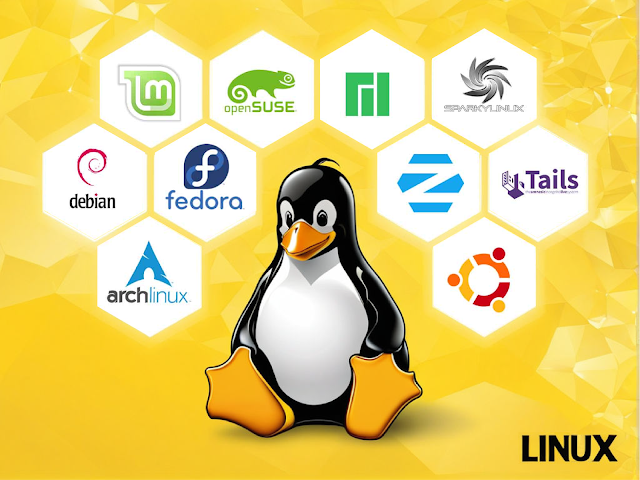A Beginner’s Guide to Linux: Unlocking the Power of Open Source
Linux is more than just an operating system; it is a revolution in the world of computing. Rooted in the principles of open-source development, Linux has evolved into a versatile platform that powers everything from smartphones to supercomputers. If you’re new to Linux or curious about its potential, this blog will introduce you to its key features, benefits, and why it’s worth exploring.
What is Linux?
 |
| Linux |
Why Choose Linux?
 |
| Why Choose Linux? |
Linux is completely free to download and use. Its open-source nature ensures transparency, making it an ideal choice for individuals and organizations seeking cost-effective solutions.
2. Security
Linux is known for its robust security features. With a permissions-based structure and an active community that rapidly addresses vulnerabilities, Linux is less prone to malware and viruses compared to other operating systems.
3. Performance
Whether you’re running a high-performance server or a low-spec laptop, Linux can be optimized to meet your needs. It’s lightweight and efficient, ensuring smooth operation even on older hardware.
4. Customization
From desktop environments like GNOME and KDE to tools and utilities, Linux offers unparalleled customization. Users can tailor the system to their specific requirements, creating a personalized experience.
5. Community Support
Linux has a vast and active community of users and developers. Forums, online tutorials, and documentation make troubleshooting and learning easier, even for beginners.
Popular Linux Distributions
 |
| Linux Distributions |
1. Ubuntu
Overview: Ubuntu is one of the most popular Linux distributions, known for its user-friendly interface and strong community support. It is an excellent choice for beginners.
Key Features: Easy installation, regular updates, and robust software availability.Use Cases: General use, office work, and programming.
2. Fedora
Overview: Fedora focuses on providing the latest software and technologies. It’s ideal for users who want cutting-edge features.
Key Features: Modern and frequently updated software.
Use Cases: Developers and tech enthusiasts.3. Debian
Overview: Debian is one of the oldest and most stable Linux distributions. It’s known for its reliability and vast repository of software packages.
Key Features: Stability, robust security, and free software.
Use Cases: Servers and mission-critical applications.4. Arch Linux
Overview: Arch Linux is a highly customizable distribution aimed at advanced users.
Key Features: Rolling release model, minimalistic base installation.
Use Cases: Users who want complete control over their system.5. Linux Mint
Overview: Linux Mint is designed for simplicity and ease of use, making it an excellent choice for users transitioning from Windows.
Key Features: Pre-installed multimedia codecs, familiar desktop environments.
Use Cases: Everyday computing, multimedia, and office work.6. CentOS
Overview: CentOS is a community-driven distribution derived from Red Hat Enterprise Linux (RHEL).
Key Features: Enterprise-grade stability and support.
Use Cases: Servers and enterprise environments.7. Red Hat Enterprise Linux (RHEL)
Overview: RHEL is a commercial distribution designed for enterprise-level applications.
Key Features: Extensive support and certifications for enterprise use.
Use Cases: Large-scale enterprise solutions.8. openSUSE
Overview: openSUSE provides a versatile platform for both beginners and advanced users.
Key Features: YaST configuration tool, strong security features.
Use Cases: Desktop and server environments.9. Kali Linux
Overview: Kali Linux is tailored for penetration testing and ethical hacking.
Key Features: Pre-installed security tools, lightweight environment.
Use Cases: Cybersecurity professionals and enthusiasts.10. Zorin OS
Overview: Zorin OS is built to make Linux accessible to new users, especially those migrating from Windows or macOS.
Key Features: Sleek and intuitive interface.
Use Cases: Personal use and multimedia.11. Manjaro
Overview: Manjaro is a user-friendly version of Arch Linux, offering an accessible entry point to its advanced features.
Key Features: Pre-configured settings, easy installation.
Use Cases: Gaming, development, and everyday use.12. Elementary OS
Overview: Elementary OS focuses on a polished, macOS-like user experience.
Key Features: Minimalist design, lightweight.
 |
| Linux Distributions |
What Can You Do with Linux?
Linux is incredibly versatile. Here are just a few examples of its applications:
Web Development: Host websites and manage servers.
Programming: Use tools and IDEs to write and compile code.
Gaming: Play an increasing number of games supported by Linux.
Education: Learn programming, system administration, and more.
Media Production: Edit videos, create graphics, and record audio using open-source tools.How to Get Started
Choose a Distro: Start with a beginner-friendly distro like Ubuntu or Linux Mint.
Create Bootable Media: Download the ISO file and create a bootable USB drive using tools like Rufus.
Try Before Installing: Most distros offer a live environment, allowing you to test Linux without installing it.
Conclusion
Linux is more than an operating system; it’s a gateway to a world of possibilities. Its open-source nature, security, and adaptability make it a powerful tool for anyone willing to explore. Whether you’re a developer, student, or just curious about technology, Linux has something to offer. So why wait? Dive into the world of Linux and discover the freedom and power it provides!




.jpg)
0 Comments:
Post a Comment